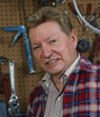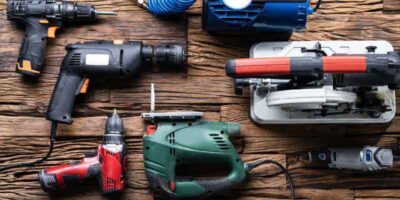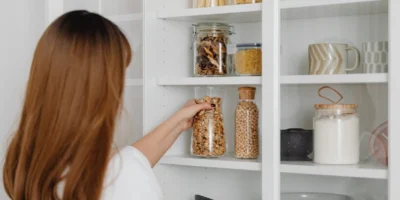When it comes to furniture construction, solid wood is often not dimensionally stable enough. However, the offered wood-based panels such as MDF or OSB have their own characteristics. Here you can learn how to Compare wood materials: OSB, MDF and Composites.
For most DIYers, OSB, MDF and Composites are old acquaintances, the plates of coarse and fine chips, hard or soft fibers, medium or high density. Anyone who builds their own furniture or interior design has hardly any alternative to them.
You should pay attention to this when buying OSB, MDF and Composites
All chipboard and fiberboard together is their bad reputation. This results from detectable formaldehyde outgassing, which in closed rooms permanently damage your health. When buying wood-based panels, make sure you have the eco-label for “low-emission wood-based panels”. This ensures that the formaldehyde load is approximately on the order of pure solid wood with OSB, MDF and Composites.
Advantages of OSB, MDF and Composites panels
The advantages of board materials are obvious. While the solid wood changes its volume and shape more or less constantly due to the absorption and release of moisture, the panels remain dimensionally stable. They owe either to the strong defibration and a high proportion of glue or the layer and crosswise production, in which the shrinkage and swelling forces virtually neutralize each other.
In order not to impair this dimensional stability, some important rules apply during processing. For example, you should always treat both sides of a plate, even if one of them will not be visible later. The paints, oils and waxes in fact affect the moisture absorption capacity. If only one side is painted, the most diffi- cult diffusion plate eventually becomes crooked.
How are material plates made?
The production of fiberboard is always similar. Coarse (OSB or chipboard) or fine chips (MDF or softboard) from wood residues of industrial wood, waste wood, construction and residual wood and unusable forestry wood are dried to a very low residual moisture content of up to 2 percent. They are then mixed with binders and / or glue and pressed together under high pressure and temperatures up to 250˚C.
What types of plates are there?
Basically, you can divide the wood panel materials into four groups. Particleboard and OSB panels form a group. They contain relatively coarse wood chips. Fiber boards (hard, medium-density and soft) are made of much finer wood fibers, which are made in special mills from the coarse chips. Veneer panels are constructed from individual layers of thin plywood. These include plywood, screen printing and multiplex panels as well as laminated veneer lumber. Composite materials such as carpenter or rod plywood panels are made of solid wooden strips that are glued between veneer top layers.
Overview of wood-based panels:
chipboard
coated chipboard
MDF board
Soft board
Hardboard
Coarse particle board
bending plywood
plywood
plywood
screen printing plate
plywood
laminboard
Glued
From top to bottom, the proportion of glue in the wood-based panels decreases. In the following we explain the characteristics and advantages of the most important board materials.
Chipboard
Chipboard is primarily cheap. Dehalb they are used in furniture and interior design. Otherwise, they do not have much to offer, which other plates can not do better.
Particle boards are more densely pressed on the two surfaces than in the board core. This creates the biggest shortcoming of the chipboard – rough and unpolished edges. The only working form of edging for you as a do-it-yourself maker is therefore the ironing on of edgebanders. Screwing and nailing close to the edges is possible, but these compounds do not withstand greater pull-out forces.
DIY stores offer ready-coated and coated chipboard in various sizes. If you want to saw for yourself, there is a problem: at the cutting edges, the coating likes to tear. Tip: If you glue a package tape along the cut line, the coating stays healthy.
MDF
MDF (Medium Density Fiberboard) panels are made of fine fibers rather than chips, which makes them much denser and more homogeneous. Big plus therefore: The plates do not splinter when Zusägen. Before painting, you must first seal the edges with putty, sand everything smoothly and coat the surfaces with an MDF primer.
When screwing MDF you have to pre-drill with about 80 percent of the screw thickness. In addition, keep a minimum distance to the plate corner of about 20 millimeters – otherwise the corner could burst. MDF costs about half as much as solid wood and is mainly used in furniture making, interior design or door construction.
OSB
OSB stands for “Oriented Strand Board”. The OSB board consists of coarse, two-directional chips. Insofar as it is also a chipboard, the characteristics differ significantly: OSB boards are much more rigid than chipboard. The adhesive content is significantly lower at 4 to 6 percent. The adhesives used are less formaldehyde than those in the chipboard and make the OSB board waterproof.
In the area you can nail, screw and clasp in good conscience. For mitred gluing, you should use lamellas (also flat dowels or wooden connecting plates). The edges are easy to screw.
Hardboard
Hardboard is only 3 to 5 millimeters thick and are mainly used in furniture making. As a drawer floor or stiffening back wall of small and large cabinets, it has certainly been installed by everyone. The lightweight yet sturdy panels are inserted into all-round pre-milled slots. But also as a filling for doors and screens, they are ideally suited.
Hardboard usually has a smooth, polished front and a rough back or they are coated on both sides. The only sensible surface treatment is gluing with foil, because you will hardly find a smoother surface for wood-based panels. The coatings offered range from simple white to various types of wood such as beech, oak or maple.
Softboards
The softboard has a low density and a porous structure and are therefore ideal for insulation. They are suitable wherever glass fiber mats are too thick and polystyrene sheets too stiff. The starting material is residual wood, so the boards are an ecological alternative to plastic insulating material.
For the attachment to the wall you need to the screws still special rosette discs, which you get in the hardware store. They claw into the plate surface and hold it tight. Original tip: Wood fiber insulation boards are also wonderfully suitable as large-sized pin boards.
Blockboards
Blockboards are composites. They consist of different thicknesses in the middle. Stake plywood is used when 24 to 30 mm thick strips are glued between the cover layers. Are the strips in the middle only 8 mm thick, the plate is called plywood plywood. Both variants have relatively similar properties and applications.
The shrinkage of the wood is compensated, the plates are very dimensionally stable. They are lighter than particle board and have a high bending load capacity. They are mainly used for furniture construction: carcasses, shelves, built-in furniture or cladding can be built from it. They are also used as formwork elements in concrete construction.
Kitchen countertops
Kitchen worktops have to endure a lot. Since it is cut with sharp knives, containers are turned off and pushed around. You can choose between solid wood (hardwood like beech or ash) and so-called postforming plates when shopping.
Postforming means that at the end of production, the plate edge is milled into shape and a resistant laminate is laid around the edge. This laminate can withstand hot pots up to 230 ° C, is shock and abrasion resistant and resistant to household chemicals. Good quality can be recognized by a watertight weld at the edges of the laminate. Solid wood panels need regular care with oil.
Veneers
Veneers are thin sheets of wood (0.3-6 mm), which are separated from the trunk by sawing, knife cutting or peeling. Subsequently, they are glued to a carrier material such as MDF, multiplex, chipboard or plywood.
Almost all types of wood are suitable for the production of veneer. From the veneered panels can be produced cheap furniture in the appearance of noble woods.
Plywood
Plywood, multiplex and laminated veneer lumber are also grouped together. Plywood consists of at least three layers of veneer glued and pressed at a 90 ° angle. It is light, stable, dimensionally stable and therefore ideal for any timber construction work. Plywood usually has a side with a smooth surface and a rough, untreated side.
Multiplex consists of five or more layers, is at least 12 mm thick and therefore also suitable as a workbench worktop. With laminated veneer lumber, the individual layers are not glued crosswise, but parallel. Stable and dimensionally stable are all three board materials. Veneer plywood is even stronger than solid wood.
 Gerhardt Richter is a writer and a trainer at trade technical colleges, specializing in carpentry, plumbing, mechanics and construction.
Gerhardt Richter is a writer and a trainer at trade technical colleges, specializing in carpentry, plumbing, mechanics and construction.




